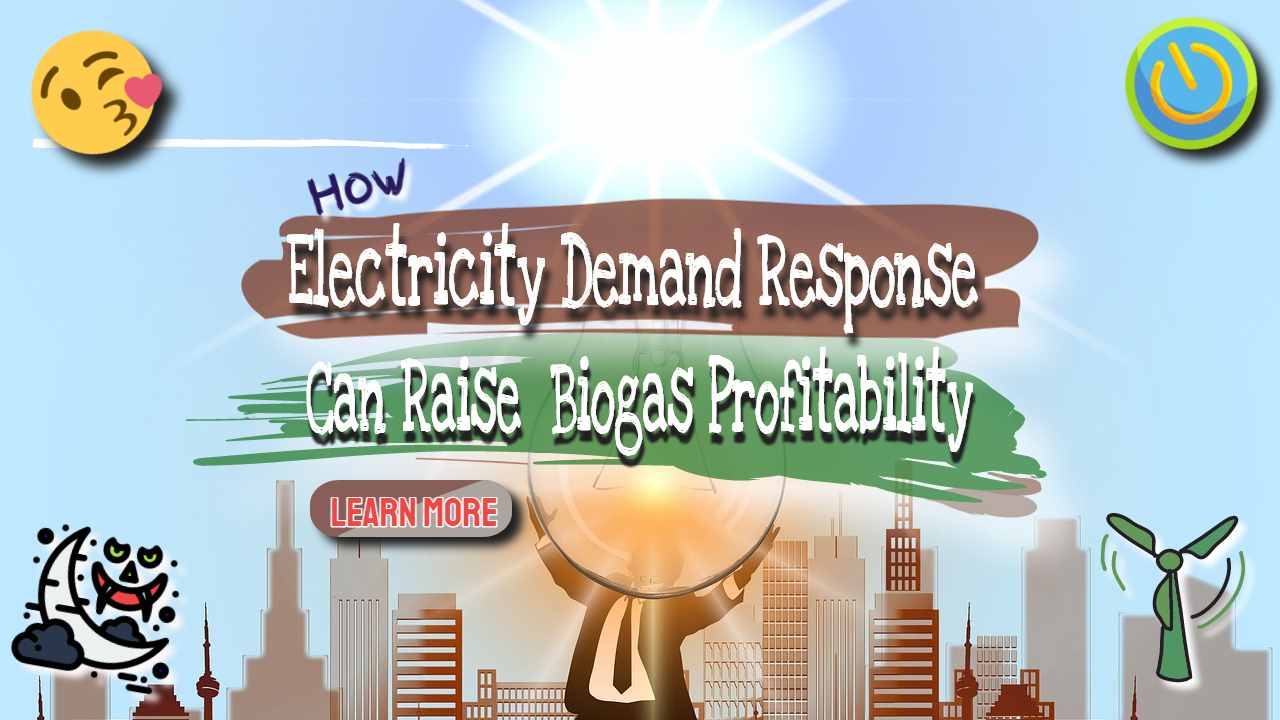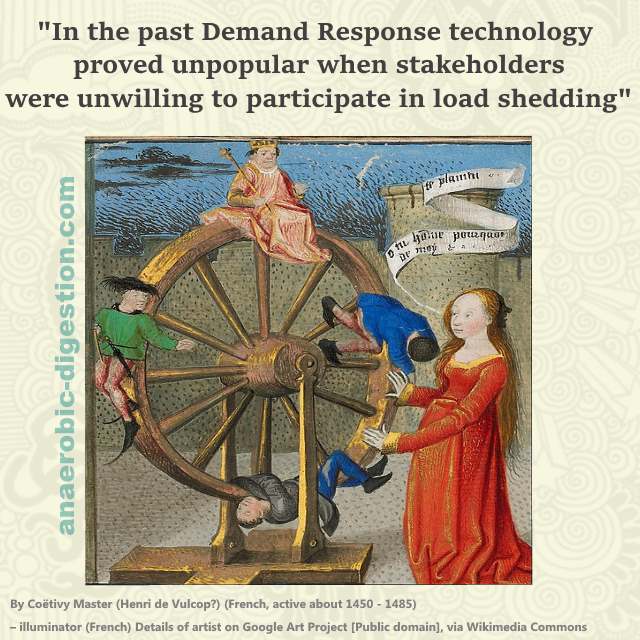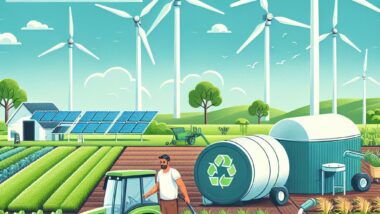Electricity Demand Response (EDR) was 10 years or so ago touted as a big opportunity for renewable power generation and that included within biogas circles, but that was when most digesters generated electricity and was before “upgrading” became the big thing.
In theory it would be used by biogas plant operators, it allows energy producers to be paid more for electricity during peak demand, easing pressure on the grid and rewarding generators with higher tariffs. At times the EDR payment can be a lot higher than normal rates!
However, since EDR was first proposed as a lucrative opportunity for the anaerobic digestion (AD) and biogas sector, real-world adoption in the UK appears to have been minimal.
In this article, we revisit the idea of EDR in the biogas industry and explain why it has not—and likely will not—become a major revenue stream for AD plant operators.
Background: The Appeal of Electricity Demand Response
The concept behind Electricity Demand Response is simple yet compelling:
- Higher Prices at Peak Times: By ramping up electricity production during periods of high demand, generators could sell at premium rates.
- Automated Control: Advanced “smart” systems can detect when the grid is under stress and automatically signal participating generators to increase output, theoretically making the process seamless.
- Supporting Renewables: As intermittent sources like wind and solar expand, EDR programs are designed to help balance supply with demand and stabilize the grid.
At first glance, anaerobic digestion seems perfectly suited for this: digesters produce biogas around the clock and can store it for short periods. Early advocates suggested that by strategically timing their digester feed times electricity generation could be raised for periods to match peak demand.
The result would be that AD plant operators could earn significantly more than standard feed-in tariffs or average grid prices.
But, it didn't happen…

Why Biogas Plants Haven’t Embraced EDR
Despite its theoretical benefits, biogas facilities worldwide have largely opted out of EDR programs. Below are the main reasons:
1. The Need for Stable Digester Conditions
Anaerobic digestion relies on microbial populations that thrive under stable, consistent operating conditions. Rapidly increasing feedstock dosing to boost biogas production for a few peak hours each day disrupts this delicate balance.
- Risk to Microorganisms: Overfeeding can lead to acidification and other imbalances, reducing biogas yield and potentially harming the microbial community.
- Overall Output Reduction: While brief spikes in biogas output sent straight to an electricity generation engine might seem profitable, they could diminish total daily or weekly gas production if the digester becomes unstable.
2. Full-Capacity Operation and Limited Gas Storage at Anaerobic Digestion Plants
Most AD facilities are designed to run continuously—24/7—at a constant gas output, to maximize gas production and energy output. To be able to run additional gas engine capacity to make extra electricity for peak demand periods in each day it would be necessary to accumulate biogas in storage for those peak hours.
- High-Cost, Low-Pressure Storage: Although biogas can be stored, typical on-site gas holders store at low pressure and are not large enough to supply a 4–6 hour demand-response window.
- Lost Baseline Revenue: Reducing generation during off-peak times to save biogas to use it peak hours can mean losing the reliable income that comes from signing up to provide constant output.
3. Rise of Biomethane Production
In regions where ADS plant to natural gas-grid connections are locally available, the profitability of upgrading biogas to biomethane (for vehicle fuel or grid injection) now surpasses that of generating electricity for the grid.
- Continuous Processing: The upgrading technologies that purify the raw biogas typically run non-stop. Halting or reducing biomethane production to switch to peak-hour electricity generation jeopardizes contractual obligations to supply biomethane.
- Market Demand: Biomethane is in high demand for transport fleets and other decarbonization initiatives, offering stable, long-term revenue without the complexity of participating in demand-response schemes.
- Introduces Weather Related Uncertainties: By joining in with EDR the operator introduces a degree of income uncertainty.
A Reality Check on Potential Earnings
The concept of harnessing higher electricity prices during peak demand still sounds appealing.
Yet, for most biogas operators, the operational and financial risks outweigh any potential short-term gains. Even if a premium tariff is achievable for a few hours, the overall daily income could decrease due to the disruption of normal feeding routines and the reduced reliability of gas supply to the generator.
The Broader Context: Decarbonization and Grid Stability
Globally, the push for decarbonization has placed a spotlight on renewable energy. Wind and solar integration has indeed made grid balancing more challenging. While AD plants provide a steady, dispatchable form of renewable energy, the logistics and economics of truly flexible power generation are much more complex for biogas than for other energy technologies.
Additionally, many new AD plants have since 2017 been configured to produce biomethane for injection into the gas grid or for use as vehicle fuel. This sector-specific trend makes short-term switching between biomethane upgrading and electricity generation even less appealing.
Existing Demand Response Mechanisms
In some markets (e.g., the UK), the grid operator offers various demand-response schemes, such as (see archive content below for an explanation of what these are):
- Short-Term Operating Reserve (STOR)
- Demand Side Balancing Reserve (DSBR)
- Fast Reserve
- Firm Frequency Response (FFR)
- Demand Turn-Up
- Triad Avoidance
While these programs can be lucrative for large-scale, rapidly dispatchable generation sources, AD facilities face unique operational constraints that typically exclude them. The few that might benefit from these schemes would require costly modifications, such as installing large-scale gas storage or batteries for fast response—an investment many operators find unjustifiable.
Conclusion
The idea of electricity demand response as a significant revenue stream for biogas facilities has not materialized and remains unlikely to gain traction. Although anaerobic digestion plants offer continuous renewable energy, the need for stable microbial conditions, limitations on gas storage, and the shift toward continuous biomethane production make flexible “on-off” electricity generation impractical.
While EDR remains a useful tool for overall grid stability, biogas operators have found more reliable and profitable pathways—chiefly, running at full capacity around the clock and upgrading biogas to biomethane. Consequently, the once-promising notion of tapping into higher peak-hour tariffs is overshadowed by real-world operational demands and market dynamics.
In short, while the concept of boosting revenues through demand response was initially enticing, the practicalities of anaerobic digestion mean that large-scale EDR adoption in this sector is improbable—and will likely remain so for the foreseeable future.
Archive of Original Article first published in 2016:
We aren't afraid to admit that we got it wrong when we said:
Electricity Demand Response Can Raise Anaerobic Digestion & Biogas Profitability
Electricity Demand Response (EDR) technology which enables energy producers to vary the unit price they charge and pay for their electricity according to supply and demand is here to stay.
The Anaerobic Digestion and Biogas Industry is well-placed to benefit from EDR technology. It can raise the profitability of these plants.
AD and biogas plants have the innate ability to store gas supplies in their facilities. They can be configured to rapidly ramp up generator output to feed electric power into the grid when it is most needed.
Half an hour or so later the rate paid per kWhr drops and AD plant generators can be wound down and output less. This is all automatically controlled via the world wide web and integrated into new “smart metering” systems which are emerging.

Biogas Electricity Demand Response Advantages
By adopting a suitable Electricity Demand Response strategy, the rate paid for the energy produced by AD plants can be an order of magnitude higher than standard feed-in tariffs.
The result is that biogas plants become much more financially viable and with a higher income they become better investments with greatly reduced payback periods.
Why is Electricity Demand Response with Variable Charging Needed
To make the energy market more sustainable and ecologically friendly, renewable energy sources such as wind and solar power have been incorporated into power systems. As a result, both the frequency and size of the supply-demand mismatch in power networks is greater than before.
Consequently, the capacity to make supply and demand changes in electricity networks must be strengthened. Biogas plants' dynamic properties, especially when paired with combined heat and power (CHP) systems, make them appropriate for EDR power generation.
Biogas is a controllable, on-demand electrical power source that may be used 24 hours a day, seven days a week.
The prospect of employing the technology as a new resource for supply-demand changes in the power grid has been favourably assessed by energy experts.
The Long Term Perogative of Decarbonization
Global warming poses serious long-term threats to people and the environment. Things we rely on and value, such as water supply, energy availability, low-cost transportation, healthy wildlife, productive agriculture and vibrant ecosystems. And, not least, human health, are all being negatively impacted by climate change.
While the public's perception of the impact of the climate issue has improved, reality has not.
For heating, cooling, transportation, and industry, the bulk of the globe continues to rely on fossil fuels. Biogas produced by the anaerobic digestion process can play an important role in the transition toward sustainability.
In the future biogas plants must produce electricity in a demand-oriented manner. This will be vital in the future energy system to compensate for the unreliability of electricity generation from variable sources such as wind power and photovoltaics.
Flexibilisation methods enable coordinated feeding management that adjusts biogas output based on various gas production kinetics of utilised substrates.
Appropriate projection models for electricity consumption could be used to enable the creation of a projected biogas output schedule.

Electricity Demand Response in the Anaerobic Digestion and Biogas Industry
Electricity demand response is being adopted in many countries to help electricity companies cope with the fluctuations in supply which are inherent in most renewable energy technologies except for anaerobic digestion.
Anaerobic digestion with its high up-time and 24/7 power production capability, is not a part of this problem.
In fact, anaerobic digestion, with its ability to store biogas as an energy source, can help by the production of electricity which can be switched on and off, to order.
Now that demand response is also considered a mainstream methodology to bring about the strategy of decarbonisation and sustainable development we thought that we would write this article, to discuss how AD Plant facilities may become involved in the electricity demand response market.
What Does “Demand Response” Mean to the Energy Industry?
Demand response (called load response by some) is defined as:
“The ability for qualifying end-user commercial customers to reduce their use of electricity when wholesale prices are high or the reliability of the electric grid is threatened. In turn, customers who participate receive discounted rates.”
On the demand side, and also the electricity companies are increasingly using “demand response” techniques, on the supply side, by allowing potential power contributors into the grid to bid for instant response peak demand period supply contracts. These are either directly overseen by National-Grid, or awarded and administrated through 3rd parties.
Bid prices for electricity provided as a demand response are always higher than standard rates.
In the UK the following Demand-Side opportunities* are available to the right businesses, amounting in all to some 15 schemes:
1. Short Term Operating Reserve (STOR):
An important source of reserve energy for National Grid, STOR is procured through 3 tenders throughout each year. Users contract to reduce usage by a specified amount with a response time of 20 minutes.
2. Demand Side Balancing Reserve (DSBR):
A time-limited tendered product aimed at major energy users willing to reduce their electricity use between 4pm and 8pm on winter weekdays in return for payment.
3. Fast Reserve:
A monthly tendered market designed to procure large blocks of reserve energy of 50MW to respond within 2 minutes.
4. Firm Frequency Response (FFR):
A monthly electronically tendered service through which National Grid procures energy that can respond within 30 seconds.
5. Demand turn-up:
A new service, under development, which will pay businesses to increase demand when there's too much energy in the system, typically responding within 10 minutes.
6. Triad Avoidance:
The practice of reducing consumption at periods where peak winter national demand is forecast (Triads), in order to reduce the transmission charges that are levied on major users.
Implementation for Biogas Producers
For AD Plant power generators, the opportunities which seem most likely to suit the AD Plant operator will be 3, and 4.
Few AD Plants will be large enough to participate in the Fast Reserve 2 minute requirement unless their owners were to install dedicated engine sets fuelled by dedicated biogas storage. However, as long as the site has the capacity to inject an additional 50MW the high price paid for the energy produced may make such an investment profitable.
To service, the Firm Frequency Response (FFR) requirement for a 30 second response time, AD plant operators could possibly install battery banks, with the batteries re-charged using biogas generated electricity.
New “Smart” Power Grid
The information systems to automatically communicate to the remote electricity demand response equipment will be essential to move the electricity supply industry from the existing grid systems to the new “smart” power grid.
The smart power grid will be essential to improve the ability of the grid operators to balance electricity supply and demand. It will be designed to do it by transferring electrical power loading to split-second accuracy.
This will be done as an electricity demand response, initiated at each electricity demand response event. Each power injection event will need to be instigated based on a pre-assessed calculated supply gap and paid for at the appropriate high electricity prices.
All this requires a new type of information system, namely a computer-based “Smart” Demand Response system.
*_ List based upon September 2016 edition of Water & Wastewater Treatment and may vary.
[Article first published in November 2016. Updated October 2021 and January 2025.]







